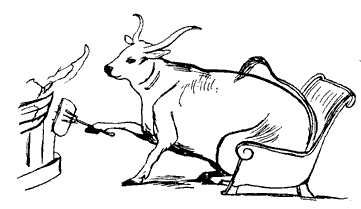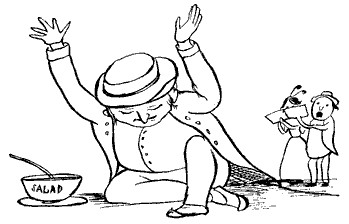No doubt you've often heard people refer to cooking as an outlet for their creativity. Certainly it can be if you let it. Cooking makes use of our ability to imagine what certain ingredients will taste like together. It can be hard sometimes to figure out which tastes go best together, but with experience and a little help from millions of home cooks who've come before you, you'll get quite good at combining flavors.
If you are a fan of watching cooking shows, it is probable that you have a good 'food imagination'. When you watch watch Chef So-and-So drop garlic into the sizzling pan, you can almost taste it. When the spices come together you can just about smell their aroma. You can use this ability to your advantage. Imagination is an important quality for a cook. It allows you come up with dishes of you own or customize the recipes you find in books or on the web. You've probably done this already when you've left out an ingredient you don't like from a recipe and added something you thought would be better. Even if you think you don't have a good 'food imagination', you know what you like to eat and that is an important thing to know.
The way I see it, learning to cook is like learning to dance.
First you learn about the equipment. In dance it's your body; You learn how to stretch and how to move. In cooking it's your utensils, gadgets, kitchen machinery and your pots and pans; you learn to how to use them and make things work.
Next you learn the basics. In dance you learn the steps one-by-one. In cooking you learn the various techniques of preparing food like how to chop vegetables or how to sauté.
Next you get a little experience putting things together. In dance you learn combination of steps and how to do a few things at the same time like turning while performing a step. In cooking you learn more advanced techniques that combine skills together like making a roux or a sauce.
After you know all the basics and get a good handle on some of the intermediate things, you can start to improvise. You use little combinations of techniques you've learned to make something appealing. Once you've mastered the techniques, you can use what you know to make something truly amazing happen. However the best things happen when someone who has a mastery of skills uses her imagination to create something exciting and new.
As in dance, the more you practice the better you'll become at different techniques. The first couple times you try to sauté something could result in something less than desirable. It happens. You still eat the food an think of what you'd do differently next time. In the worst cases, the failed attempt goes in the trash. It happens even when you are a 'good' cook.
Using your creativity to try to imagine what tastes good together is the same way. You need to practice it to get good at it. When I find myself cooking the same thing over and over again, it gets really easy. It also gets boring. I like to revisit my old standby recipes and try using new and different flavors once in a while. You can change the flavor by varying the ingredients, herbs/spices, or cooking methods. An exercise I like to try is using a standard basic recipe and trying different combinations of herbs each time I make it.
Feeding your mind is a great way to feed your creativity. For me this involves cooking recipes from certain traditions and then using little combinations from those recipes. I also pay attention to the flavors that almost always accompany the main ingredient I'm cooking such as meat, chicken or special vegetables. It can help to have little themes or stories for your seasonings. This helps you recall groups of ingredients that taste good together.
Flavors grouped by ethnicity might include:
- thyme, garlic and wine - France
- oregano, basil, garlic and Italian parsley - Southern Italy
- curry, turmeric, ginger and fenugreek - India
- cumin, cilantro, lime and jalapeño - Mexico
- ginger, mint, lime and cilantro - Thailand
You can also group things by traditional main dish associations:
- for poultry - parsley, sage, rosemary, thyme (like the song!) and sometimes celery seed or paprika
- for pork - parsley, sage and basil
- for white fish - butter, lemon, dill and pepper
A great source for basic recipes is the The Joy of Cooking
The following is the basic beef stew recipe from The Joy of Cooking. I like it because it gives you the technique to build any stew. My favorite herb to use with this recipe is thyme. I almost always add red wine when I do. When I get tired of thyme, I pick another herb from the list and build my changes to the recipe from there. Here's a few variations:
version 1 - French thyme & wine, leaving out parsnips, extra garlic
version 2 - English thyme (more bitter) & beer, using all veggies but no garlic
version 3 - 1/2 oregano, 1/2 basil, using beer, adding 8 oz sliced crimini mushrooms, no leeks
These variations may seem subtle, but they do produce different results. Try out your own and see what you like best. I almost never make the same dish exactly the same.
Basic Beef Stew
6 to 8 servings
By altering the vegetables or the proportions, the recipe variations are limitless. For a fresher flavor, add more vegetables or herbs toward the end of cooking. For a deeper flavor, use a few spoonfuls of Meat Glaze to enrich the sauce.
Pat dry:
2 pounds boneless stewing beef, such as chuck, short rib meat, or bottom round, cut into 2-inch cubes
Season the meat with:
1/2 to 1 teaspoon dried herbs (thyme, marjoram, savory, oregano, and/or basil)
1/2 teaspoon salt
1/2 teaspoon ground black pepper
Dredge the meat with:
1/2 cup all-purpose flour
Shake off any excess flour. Heat in a Dutch oven over medium-high heat:
2 tablespoons olive or vegetable oil, bacon fat, beef drippings or other fat
Add the meat in batches and brown on all sides, being careful not to crowd the pan or scorch the meat. Remove with a slotted spoon. Pour off all but 2 tablespoons of fat from the pan (add more if needed).
Add:
1/2 cup chopped onions
1/2 cup chopped carrots
1/4 cup chopped celery
1/4 cup chopped leeks (optional)
2 tablespoons chopped garlic (optional)
Cook and cover, stirring often, over medium heat until the onions are softened, about 5 minutes
Add:
2 bay leaves
1/2 to 1 teaspoon of the same herbs used to season the meat
1/2 teaspoon salt
1/2 teaspoon ground black pepper
Return the meat to the pot and dd enough to cover the meat at least halfway:
2 to 3 cups beef or chicken stock, dry red wine or white wine, or beer
Bring to a boil. Reduce the heat, cover and simmer over low heat until the meat is fork-tender, 1-1/2 to 2 hours.
Add:
2 to 3 carrots, peeled and cut into 1-inch chunks
3 or 4 boiling potatoes, peeled and cut into 1-inch chunks
2 turnips, peeled and cut into 1-inch chunks
2 parsnips, peeled and cut into 1-inch chunks
Cover and cook until the vegetables are tender, 35 to 40 minutes. Remove the pan from the heat and skim any fat from the surface. Taste and adjust the seasonings.
Garnish with:
Chopped fresh parsley
My own additions from time to time:
8 oz sliced mushrooms
1 cup pearl barley
cooked egg noodles
a handful of green beans


